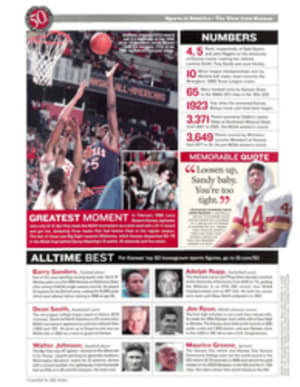
The Cover Story: Why getting covered by SI is complicated
The cover is the face of any magazine, the first thing readers
see, the place where the editors declare their intentions. At
Sports Illustrated the cover has inspired keen interest bordering
on obsession since late 1953, when Sid James struggled over which
images to use on the two issues he was putting together for
prospective advertisers and selected sports editors in order to
determine whether the country wanted or needed a sports weekly at
all. The cover photograph on the first dummy was a shot of the
crowd at Oklahoma's rainy November football victory over
Nebraska. The absence of football action from the frame
underlined the basic SPORTS ILLUSTRATED proposition: that a new
leisure class with a growing interest in recreation was a sports
magazine market waiting to happen. (This image eventually
became the third of SI's 152 college football covers.) The
cover of the second dummy was a golfer, framed by spectators,
teeing off at the 16th hole at Cypress Point, and inside the
magazine, in addition to the golf piece, was an eclectic mix of
stories on hunting, fishing, snorkeling, bowling and Ping-Pong
(even a piece on 15th-century jousting art) as well as
baseball, motor sports and horse racing. In both cases, the
cover images took the spectators' point of view and evoked the
pleasure of watching sports.
As you will discover in the following pages, part of SI's ongoing
celebration of its 50th anniversary, cover subjects can be
subdivided into many categories, both metaphysical and
statistical. But rather than wondering how many angels can dance
on the head of a pin, try to think about how many times Angels
have made the cover (10 times for the L.A./California/Anaheim
Angels, two times for jockey Angel Cordero and another four for
Elle Macpherson). The best news is that every cover is reprinted
here, all 2,548 of them. That covers the waterfront (OCEAN
SAILING, 1966), covers more ground than Jim Brown (SECRETS OF A
FULLBACK, 1960) and covers a multitude of sins (Dennis Rodman in
a stud collar, 1995).
Any way you look at it, an SI cover becomes an almost instant pop
icon (often shot with a Nikon) that also means something to
athletes. "When I was on the cover the first time my senior year
at Penn State, my first reaction was shock," says Joe Jurevicius,
the Tampa Bay Buccaneers' receiver who also appeared on the Super
Bowl cover last February. "Since I was old enough to read the
words Sports and Illustrated, it was something I dreamed about. I
was the kid who had a subscription at home, but if I was in a
doctor's or a dentist's office, I'd steal their copies." Bucs
rookie quarterback Chris Simms has a variation on that same
theme: "It's thrilling to see yourself on the cover. It always
brings a smile to my face when I remind my dad [former New York
Giants quarterback Phil Simms] that I've been on the cover
[twice], one more time than him."
Being No. 1 is also a recurring cover theme, and that's not
counting the infamous 1972 cover when Walter Iooss's photo of
Miami Dolphins running backs Jim Kiick and Larry Csonka featured
Csonka surreptitiously flashing his middle finger. The editors
missed it, but a riot of howling letters filled them in soon
enough. In fact, SI receives more comments about its cover
choices than any other subject, and write-in campaigns are
mounted at least once a year--most recently for Iowa State
wrestler Cael Sanderson, who was worthy but overtaken by
difficult hockey news (THE DEATH OF A FAN, 2002) the week he won
his 159th straight match and his fourth NCAA title.
Of course there are some readers who believe that making the
cover is not necessarily a good thing. Not that being on the
cover 22 times has adversely affected Jack Nicklaus. Nor did
Michael Jordan, who hit the cover trifecta by being photographed
while playing basketball, golf and baseball, suffer from his 49
appearances. Still, the so-called SI cover jinx is part of
America's sporting mindscape, the great unscripted drama, wherein
strange things have happened with uncomfortable frequency since
the early days of the magazine. Like life itself, a weekly
magazine is largely about timing, and in that era of primitive
color photo technology, the cover had to be sent to the printer
six weeks before publication. Eighteen-year-old Jill Kinmont, a
U.S. ski champion, was on the Jan. 31, 1955, cover. (SI is dated
five days ahead of the day it goes on sale.) Tragically, during a
run on Jan. 30, Kinmont lost control, struck a tree and was
paralyzed.
The jinx as we understand it today is about winning and losing,
not life and death, and it has much less to do with paranoia than
probability. Both teams and individuals tend to make the cover
when they're doing exceptionally well, and no one does
exceptionally well forever, so the odds that a cover subject will
return to earth--and a more normal level of performance--are
great. Thus the perception of a causal relationship: the jinx. We
don't believe in it, but it contributes to the iconic nature of
SI covers.
At SI, it is the managing editor who has the final call on the
cover, and the eight men who have held the job over the last 50
years agree that the cover choice is most often about honoring
character and achievement in sport. It is also about not making
mistakes. For example, in October 1988 SI jumped on the
late-breaking story of Ben Johnson's positive drug test after
he'd finished first in the 100 meters in Seoul and, on deadline
(and faster than you can spell S-t-a-n-o-z-o-l-o-l) kept the
original shot of Johnson in motion but changed the cover line
from WHOOSH! to BUSTED!
The covers always have had as much rhyme (PITT IS IT!, THE DRIVE
FOR FIVE and George Foreman's BLAST FROM THE PAST) as reason
(Notre Dame quarterback Tony Rice has outcovered home run king
Hank Aaron 4-3). But then, SI covers have always been closer to
snapshots of their week than oil paintings of their era. The
covers were simpler in the 1950s, when America apparently had
more time for HUNTING THE CHUKAR PARTRIDGE (1955) or musing over
the YALE-DARTMOUTH GAME PREVIEW (1956). Now there are more action
photos, more text, more punctuation and small inset photos--sort
of covers-within-a-cover, like the pictures-within-the-picture on
your 36-incher in the den.
There is not a greater student of SI covers than Scott Smith, who
has put together a collection of autographed covers that
includes, by his calculation, 94.8% of the 2,548 covers the
magazine has run to date. It is thought that the relentless Smith
will stop at nothing, which is almost true. In 1988 he made a
trip to L.A., hunting for SI cover subjects. One of his stops was
the hospital bed of bridge expert Charles Goren, who had appeared
on SI's cover three times, in 1957, '60 and '64. Smith waited,
magazines and Sharpie in hand, murmuring "Charles? ... Charles?"
But he swears he did nothing as brazen as shake the frail and
ailing man who was on a ventilator and enmeshed in a thicket of
tubes, and who did not awaken to the strange voice in his room.
Goren never did sign for Smith, but otherwise it was an
outstanding trip. Rafer Johnson, the great decathlete who worked
with the Special Olympics, graciously signed in his office in
Santa Barbara. When Smith went to what he thought was 1976
Olympic decathlon champion Bruce Jenner's home, his ex-wife
explained over the intercom that "when he divorced me, he lost
the house." She did, however, give Smith Jenner's new phone
number. Smith called, and Jenner invited him over. They hung out,
drank beer and took pictures with Jenner's gold medal, and Smith
walked off with signed covers. He also located a future governor
of California at the gym, pumping iron, not hands, as he would 13
years later, and nailed his autograph. Houston McTear, the
world's fastest man for a nanosecond in the late 1970s, was more
problematic. McTear was homeless, sleeping most nights under the
Santa Monica pier. Smith went to a van serving food to homeless
people to see if the sprinter had stopped by for a free
breakfast, but he hadn't, so Smith offered a few men who were
there $10 each for information. The men went off and, 30 minutes
later, returned with McTear in tow.
Smith recalled this trip while sitting in the basement of his
northern New Jersey home where his signed covers are catalogued
by sport, alphabetized, placed in plastic folders and stored on
shelves. Several thousand more unsigned copies are piled in his
garage. Off the top of his head he can name the Soviet runner who
is shaking hands with Frank Shorter on a 1970 cover (Leonid
Mikitenko) and the color of the golf shirt Ohio State defensive
tackle Dan (Big Daddy) Wilkinson wore for his cover shot in 1995
(blue). Smith works in sales for a company that restructures
debt, but since receiving his first SI subscription at 13 from
his grandmother, getting covers signed has been what he really
does. And each week he judges the book by its cover: easy signs,
hard signs.
Smith's is a Sisyphean task. As soon as he gets his latest cover
signed or tracks down an autograph he has waited a decade or more
to nail, a new issue arrives in his mailbox. (No Greek
mythological figure has graced the cover, but four football
players from Athens, Georgia, have.) Smith embraces the
challenge, although in the age of the Internet his research has
become less daunting. Sometimes it takes money--Smith bought a
signed 1967 Roberto Clemente cover on eBay for $900 in 2000,
although he refuses to pay the $750 per signature he says Mark
McGwire charges.
Smith estimates his SI collection is worth over a million
dollars, a reminder that a picture can be worth more than 1,000
words ... if it is autographed by Ali, Nicklaus or even Dewey
Buck, the Oklahoma trombone player who made it in 1954. Smith
says his obsession has never been primarily about money. "This is
just a blast, seeing who's on the cover and then getting it
signed."
Most readers, however, simply want to see who made the cover, and
that choice can resonate--as the late Charles Goren might have
said--in spades.
If we get it right. --Terry McDonell

